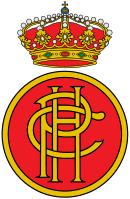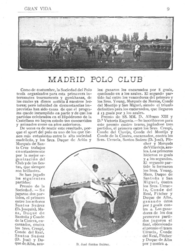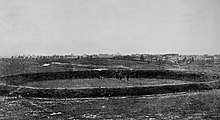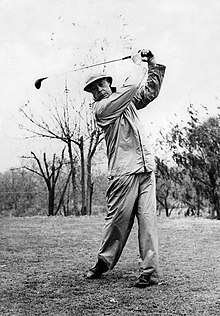Real Club de la Puerta de Hierro
Real Club de la Puerta de Hierro (Spanish pronunciation: [ře 'al 'klub de la 'pwer ta ðe 'je řo]; "Royal Club of the Iron Gate"), commonly known as Puerta de Hierro, is a private country club based in Madrid, Spain. It owes its name to the nearby iron memorial arch.[5] Notorious for being associated with the royal families of Europe and the long-established elite, American President Gerald Ford called it "the club of kings and the king of clubs".[6]
 | ||||||
| Nicknames | Puerta de Hierro | |||||
|---|---|---|---|---|---|---|
| Sport | Golf Polo Horse Riding Tennis Padel Croquet | |||||
| Founded | 1895[1][2][3][4] | |||||
| Based in | Avenida de Miraflores, s/n 28035 Madrid Spain | |||||
| Colors | ||||||
| Owner | Members | |||||
| President | The Count of Bornos | |||||
| Honorary President | Felipe VI | |||||
| Website | http://www.rcphierro.com | |||||
It was established in 1895 as a polo club by a group of prominent noblemen led by the 16th Duke of Alba, with avid support from the then king of Spain, Alfonso XIII. Along with the Ritz Hotel, it was founded as an effort to equal the likes of the most luxurious venues of London and Paris.[7] In 1904, Harry Colt and Tom Simpson designed in the club what was to become mainland Spain's first golf course, "el de arriba" (the upper).[8] In 1966, Robert Trent Jones Jr. and John Harris designed the second course, "el de abajo" (the lower). The golf courses at Puerta de Hierro have hosted the Spain Open, Madrid Open, the 1970 Eisenhower Trophy and the 1981 Vagliano Trophy, and are considered "one of the finest and most classic courses in continental Europe".[9][10][11] Besides golf, the club has a long-recorded history and sections in the fields of Equestrianism, Tennis, Padel and Croquet.
Puerta de Hierro is well known for its strict membership policy. For more than 30 years, admission remains closed; only sons, daughters and spouses of existing members are allowed to join (the latter lose their status as members if they seek divorce). The club has been subsequently referred to as "the most exclusive and segregated club not only in Spain, but possibly in the world, were one can fraternize with the restrictive high society of Madrid".[12] Groucho Marx's quote, "I don't care to belong to any club that will have me as a member" has been used to describe the club's highly sought-after membership.[13]
History
Early days
In 1876, a 19-year-old Alfonso XII ordered the construction of Madrid's first polo field at the Real Casa de Campo, at the time property of the crown. The main hypothesis behind this impulse points at the then Prince of Wales (later Edward VII), who during a visit to Madrid in late April 1876 mentioned the game to the king for the first time. The Prince of Wales had just returned from Colonial India, where he had witnessed one of the first oficial matches of polo, between a British garrison and the local Manipurs. Such was the enthusiasm of the future king Edward VII that his relative Alfonso was immediately captivated upon hearing his anecdotes.[14]

The sport of polo was relatively new to Western Europeans; in 1872, the Marquess of Torre Soto founded the "Jerez Polo Club" in Jerez de la Frontera while The Hurlingham Club published the official rules in 1873.[15][16][17] The Duke of Tamames, who had been educated in England, was also one of the main pioneers of polo in Spain.[14] Another important factor in the popularisation of the game was the great amount of business that British entrepreneurs were involved with in Spain, mainly transportation, sherry and mining i.e. Río Tinto, Osborne Group or González Byass. This common exposure to the British 'passe-temps' and colonies introduced in Spain not only polo but also golf and tennis.[18]
Young Alfonso XII, who had studied at Sandhurst, commissioned his admired equestrian teacher colonel Hamley to issue him with the newly published rules of Hurlingham. The king played polo up until his premature death in 1885, establishing the sport definitely amongst the upper classes of Spain. With the closure of the pitch at Casa de Campo as a result of the king's death, his close group of friends started playing polo in a large grassland in what is now Moratalaz in 1893. This group of enthusiasts was comprised by the dukes of Arión and Santoña and the marquesses of Larios, Villamejor and San Felices de Aragón.[18]
With the constantly growing devotion towards the game in Madrid, the idea of founding a club was more plausible than ever. This way, the 5th May 1895 the Duke of Alba established what was then called "Madrid Polo Club". Amongst the first board members were the Duke of Santoña, the Duke of Arión and the Count of Torre Arias, with the Queen Regent as honorary president. During the first board of the club, Spain played its first international polo game between the newly founded society and the Gibraltar Garrison Polo Club, in Granada, the 21st July 1897. The Spanish side included the brothers Leopoldo, José and Ernesto Larios and the Duke of Arión. The components of the English side are unknown, but it is most likely that they were officers of the Queen's Own Cameron Highlanders, which were posted in Gibraltar during the time.[19]

Around the same time, Alfonso XIII, who had been born king, was not yet 10 years old. Despite his young age, his delicate health had prompted his mother the Queen Regent to ensure he practised many outdoor sports, and so the king had become a prolific horseman. A decade later, in 1908, he played polo in public for the first time, becoming the first monarch of the modern age to do so.[19] The young king had also become a keen golfer in England, and so decided a 9-hole golf course be built in the Madrid Polo Club. In 1901, the course was inaugurated and became extremely popular, with figures such as Prince Carlos and his brother Prince Rainero being frequent players.
In 1907, the golf course had been so successful that the 391 members of the time acquired a larger estate known as "las Cuarenta Fanegas", making reference to the 40 fanegas of land that the Duke of Ahumada had granted for the construction of a garrison of the Guardia Civil in the mid 19th century.[20] It was located near present-day Santiago Bernabéu Stadium. With the considerable growth of golf within the club, it began to take the name of "Madrid Polo-Golf Club". For the design of the new course (the first 18-hole in the country), the board elected John Henry Taylor as architect. Not much is known today about this primitive course, other than its deep bunkers and the ring-like greens baptised then as bullrings, a uniqueness that the "American Golfer" magazine portrayed in one of its issues in April 1914.[21] The clubhouse resembled a British-Indian bungalow.

With the addition of lawn-tennis (on the lines of the Real Sociedad de Tenis de la Magdalena) in 1912, the club searched for larger terrains to cater for the new sport and the rapidly growing memberships. King Alfonso XIII offered some land in Monte del Pardo belonging to Heritage of the Crown for the symbolic price of 1,000 annual pesetas for a period of 20 years. The new terrain was situated near Puerta de Hierro, a triumphal arch built by Ferdinand VI in 1753. The transferral of all the facilities and members to the new location proved difficult. Back then, very few people had cars, the road to Puerta de Hierro was muddy and out of reach for those living in the city, which represented the great majority of members. Allegedly, the king had to speak to several influential members so that they would convince the rest to move out to the new terrains, claiming "it is an act of patriotism, since Madrid needs a country club that the best of those existing abroad would not surpass at all".[22] Once there was consensus, the members planned the funding of the construction of new facilities, which was wholly out of members' donations.
The club subsequently took the name of the monument later in 1912, and added the prefix real (royal) along with the Royal Crown on bestowal of king Alfonso XIII, thus becoming "Real Club de la Puerta de Hierro".[22]
1940s
On June 23, 1940, Edward VIII visited Madrid as Duke of Windsor, staying at the Ritz Hotel. The purpose of this extra-official visit, in the midst of the German invasion of France, was to negotiate possible alliances with Nazi Germany from Axis-leaning Spain.[23] On June 24, The Duke of Windsor spent the day at Puerta de Hierro, where he played golf and attended a St John's Eve party at the club accompanied by the then Marquess of Estella, son of former dictator Miguel Primo de Rivera and brother of José Antonio Primo de Rivera. During the celebration, Windsor was surprised with news from a British aristocrat who owned wineries in Spain and had recently returned from London. As he was told, his brother King George VI had granted an Earldom to former Prime Minister Stanley Baldwin, who he loathed. He complained "why on earth would Bertie reward such nauseating reptile?".[24]
The Duke of Windsor would return to the club on several occasions, most notably in 1960, when he famously played golf under pouring rain.[25]

Club Presidents
- 1895 – 1896 The Duke of Alba[26]
- 1896 – 1901 The Duke of Arión
- 1901 – 1905 The Duke of Santoña
- 1905 – 1931 The Duke of Alba
- 1931 – 1932 The Marquess of Portago
- 1932 – 1936 Rafael Silvela y Tordesillas
- 1939 – 1944 Joaquín Santos-Suárez y Jabat
- 1944 – 1950 Rafael Silvela y Tordesillas
- 1950 – 1952 The Count of Fontanar
- 1952 – 1954 The Duke of Lécera
- 1954 – 1958 The Count of Fontanar
- 1958 – 1962 The Duke of Frías
- 1962 – 1966 H.R.H. Prince Ataúlfo de Órleans y Sajonia-Coburgo-Gotha
- 1966 – 1970 The Marquess of Silvela
- 1970 – 1974 The Count of Villacieros
- 1974 – 1978 The Duke of Fernán Núñez
- 1978 – 1986 The Duke of Bailén
- 1986 – 1990 The Marquess of Estepa
- 1990 – 1994 The Marquess of Bolarque
- 1994 – 2006 The Count of Elda
- 2006 – 2011 Pedro Morenés y Álvarez de Eulate
- 2011 – 2016 Luis Álvarez de las Asturias Bohorques y Silva
- 2016 – The Count of Bornos
Honours
National honours
See also
| Wikimedia Commons has media related to Real Club de la Puerta de Hierro. |
References
- "ABC MADRID 04-07-2014 página 96 - Archivo ABC". abc. September 6, 2019.
- Riordan, James; Kruger, Arnd; Krüger, Arnd (May 22, 2003). European Cultures in Sport: Examining the Nations and Regions. Intellect Books. ISBN 9781841500140 – via Google Books.
- "El marido de Esperanza Aguirre: Ahora, el presidente es él". ELMUNDO. March 19, 2016.
- Laffaye, Horace A. (March 10, 2015). The Polo Encyclopedia, 2d ed. McFarland. ISBN 9780786495771 – via Google Books.
- "Mazo, Violeta: Sólo apto para socios - 25 June 2004". 25 June 2004. CincoDías EL PAÍS
- Gómez Laínez (2010). p. 117
- "Castelló, Elena: Así es por dentro el club más exclusivo de España, y donde la nieta de Suárez celebra hoy su boda - 21 April 2018". 21 April 2018. Vanity Fair
- Ten Golf: El club de golf más antiguo de España cumple 125 años (Puerta de Hierro is the second oldest in Spain, after Real Club de Golf of Las Palmas, founded 1891, but is the oldest in mainland Spain)
- "Real Club de la Puerta de Hierro (Arriba) - Top 100 Golf Courses of Spain". www.top100golfcourses.com.
- "Real Club de la Puerta de Hierro (Abajo) - Top 100 Golf Courses of Europe". www.top100golfcourses.com.
- "Real Club de la Puerta de Hierro - LUXOViS | The World of the Luxury! Find the luxury Hotels, Villas, Restaurants, Shops, Events, News, Golf, Beauty and Health - Find and book the Luxury in the world, make a luxury reservations". luxovis.com.
- "Real Club Puerta de Hierro: el feudo de la derecha". El Confidencial. April 1, 2015.
- Hello! No. 1030 - 22 July 2008 p. 11
- Gómez Laínez (2010). p. 18
- Edward Darley Miller, Modern Polo, Hurst and Blackett, 1902, p. 333
- Thomas Francis Dale, Polo past and present, Offices of Country Life, 1905, p. 24
- Drybrough, T. B. (May 22, 1906). "Polo". Longmans, Green – via Google Books.
- Gómez Laínez (2010). p. 19
- Gómez Laínez (2010). p. 20
- Gómez Laínez (2010). p. 23
- Gómez Laínez (2010). p. 25
- Gómez Laínez (2010). p. 37
- Juárez, Javier: El 'contubernio' del Hotel Ritz - 31 January 2017 - El Mundo
- Vilches, Juan: Te prometo un imperio. Barcelona (2013) pp. 22-24
- Limited, Alamy. "Stock Photo - 1968 - The Duke of Windsor King Edward VIII - The Duke of Winsor plays golf in the rain Pouring rain did not deter the Duke of Windsor from playing a round of golf at the Real". Alamy.
- Gómez Laínez (2010). pp. 15-16
- Real Orden del Mérito Deportivo 2013 csd.gob.es
Bibliography
- Gómez Laínez, Mariola (2010). El Real Club de la Puerta de Hierro. Ediciones El Viso. ISBN 978-84-95241-75-7.